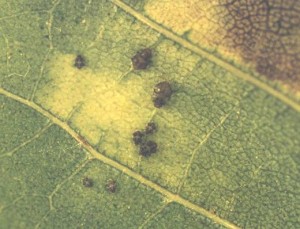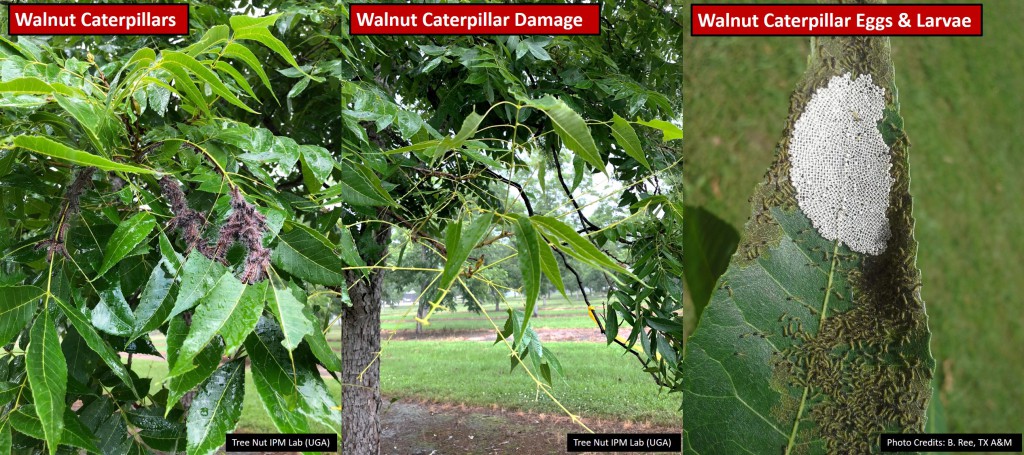Pro Gibb Applications for Black Aphid in Pecans (Lenny Wells)

Black aphid nymphs and feeding damage
For those battling black aphids and considering using Pro Gibb to prevent the damage caused by this insect, applications should begin in mid July and continue for a total of 3-4 sprays. Pro Gibb prevents the development of chlorotic areas caused by black aphid feeding on the foliage. In the past we have advised using the 4% Pro Gibb material since heavy rates or application at the wrong time can lead to negative results for your trees. However, the 4% material is no longer made and Valent has replaced it with a 5.7% material. This formulation is safe to use on pecans and is labelled at the 5 oz rate. Based on Dr. Ted Cottrell’s work at USDA in Byron, the schedule for Pro Gibb applications should be as follows:
Mid July: Pro Gibb 5.7% at 5 oz/acre
Early August: Pro Gibb 5.7% at 5 oz/acre
Mid August: Pro Gibb 5.7% at 5 oz/acre
Late August: Same as above if needed
Apply an aphicide along with Pro Gibb when black aphids reach threshold levels (15% of the terminals sampled have more than one black aphid adult with nymphs present on a compound leaf) in August.
Walnut Caterpillar and Fall Webworms in Pecans (Lenny Wells)
Dr. Will Hudson and I have been receiving reports of walnut caterpillar and fall webworm sightings in pecan orchards, particularly in young trees.
These two caterpillar pests are both foliage feeders and they occur in groups, but the main difference is that walnut caterpillars do not make webs like the fall webworms. They both have two generations per year. Both feed gregariously, but walnut caterpillars move down to the main trunk as a group during the day while webworms spin a web nest at the tips of the branches to protect them while they feed. The web expands to cover more leaves as the caterpillars grow. Once the larvae of both species are done feeding, they move to the ground (via the trunk) and pupate in the ground.
Walnut caterpillars have a narrow host range feeding on leaves of pecan, hickory and walnut trees (~10 species). The larvae feed in groups and the damage is shown as skeletonized leaves normally with just the stalks left. Aside from scouting for the damage, you can also scout for their eggs which are normally laid in groups.

Fall webworms have a wider range of host plants including many fruit, nut and ornamental trees (~120 plant species). They also occur in groups (100+ caterpillars) but are much more obvious due to the webs they produce which covers small branches, twigs and leaves. The damage they cause on the foliage are characterized by the uneven/irregularly shaped appearance of the leaves which would turn brown. Their eggs are also laid in masses of 100+ eggs.

MANAGEMENT: For both of these pests, light infestations do not normally warrant control unless the whole tree is infested or if they infest younger trees. For smaller and localized infestations, you can physically remove the infested limbs with the caterpillars and crush/burn them. If you can reach the webs, tearing them up with a long stick or pole will greatly reduce the problem by making the caterpillars more vulnerable to predators and parasites. Removal of egg masses before they hatch would also be recommended.
For spray applications, caterpillar-targeted materials such as Dimilin and Intrepid can be used.
Authors: A. Acebes-Doria and W. G. Hudson